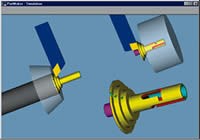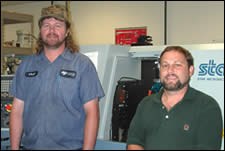Turning Small Parts In A Big Way
True to its Southern heritage, Count On Tools (Gainesville, Georgia) makes money the old fashioned way: By earning it. This shop does so by manufacturing complex parts on its multi-axis CNC Swiss smarter and more efficiently than other suppliers to the printed circuit board (PCB) industry.
True to its Southern heritage, Count On Tools (Gainesville, Georgia) makes money the old fashioned way: By earning it. This shop does so by manufacturing complex parts on its multi-axis CNC Swiss smarter and more efficiently than other suppliers to the printed circuit board (PCB) industry.
The company specializes in manufacturing the nozzles used to fuse microscopic electronic devices onto circuit boards. These circuit boards then go into any range of electronic devices, from desktop computers to cellular phones. In some cases, the nozzles the company machines are used to pick up devices the size of a salt granule (about 0.01 by 0.02 inch). The company has made nozzles with holes as small as 0.005 inch in materials ranging from 440, 303, A2 and a range of exotic plastics.
Currently, Count On Tools’ roster of equipment includes two Star SR-20R Swiss-type lathes and a nine-axis Star SV-32. The company bought its first Star SR-20R—one of the first SR-20Rs in the United States—in 1998. Upon acquiring the company’s first Star, president and founder Curt Couch became eager to find a CAD/CAM programming system that would allow his company to program its complex components quickly while using the full capabilities of the machine. Count On Tools adopted PartMaker SwissCAM from IMCS Inc. (Fort Washington, Pennsylvania) in 2001 to achieve this goal.
“When we started looking for software, I realized that we were getting a smoke screen everywhere we looked,” says Mr. Couch. “Even after we bought PartMaker, nobody believed that it would do what it would do. They just didn’t believe it. They do now.”
How CAD/CAM Software Helps
More than anything, PartMaker SwissCAM helps Count On Tools by allowing it to handle the most complex aspects of Swiss programming quickly and easily.
“One of the most helpful aspects of PartMaker is its ability to do engraving and other types of milling interpolation on the face and diameter of a part,” says Mr. Couch.
“Before we got the software, we were sending our parts through a laser engraver or just flat out not engraving them,” he continues. “We had no product identification. But because the software has made it so easy, we are engraving our parts now.”
PartMaker greatly simplifies complex programming, such as C-axis engraving, through its Visual Programming approach. The software operates from graphical representations of the part’s various faces. The system breaks a complex part into a set of faces. The faces can be planar or rotational, and each can contain various machined features such as holes or J slots. A specific machining function such as turning, polar milling or cylinder milling is assigned to each face. A dedicated window, referred to as a face window, contains a workspace for the graphical representation of the face features.
Rather than create a job plan in a conventional sequential manner, the programmer describes the group placement of part features on the machined part’s surfaces. Once the part feature description is entered into the computer, the software automatically generates an optimized job plan. The results job plan results are summarized on a process table. The table lists tools and cutting conditions for each process. Feed rates, spindle speeds and cycle time are automatically calculated and displayed.
Once generated, the process table allows the programmer to synchronize operations being performed simultaneously. This is where the software is said to shine, because it allows programmers to choose the type of synchronization strategy being performed from graphical diagrams. For example, if the user wants to cut with one tool on the main spindle while cutting with another at the same time on the subspindle, he or she chooses a diagram corresponding to that type of synchronization by simply pointing and clicking. These visual synchronization strategies are applied to every process on the part. Because the software knows the architecture of the machine being programmed, it checks that the synchronization strategies used by the programmer will actually work. If the programmer tries to synchronize operations in a manner the machine cannot handle, the software indicates where the error has occurred.
When synchronization has been completed, the software displays a balanced cycle time, showing how much time is being spent on the main spindle, how much time is being spent on the subspindle and the total machining time, taking into account all concurrent operations. At this point, the programmer can see if additional cycle time reduction opportunities exist and make the changes accordingly.
A built-in drawing capability allows the user to draw a part from a part print or to import geometry directly from virtually any engineering system. In Count On Tools’ case, this often means importing a part designed in Solidworks. Importing solids directly into PartMaker has further reduced programming time because it eliminates the need to recreate part geometry. But sometimes parts may not come with a print, so PartMaker’s integrating CAD package can come in handy as well.
“I can give Chad [Parker (the company’s lead programmer)] a part without a drawing, and he can sit there and program it and have it ready and set up in the machine in a couple of hours,” Mr. Couch says. “I don’t have to have a drawing.”
Dropping The Part Complete
Dropping parts complete off of its Swiss machines is critical for Count On Tools because the company often finds itself running small lot sizes. Lots can range in size from five to 5,000 but are often 50 to 100. As a result, Mr. Parker is typically creating two to three new programs a week for the Stars.
Regardless of the number of parts, Mr. Couch cannot stand the thought of having to manually debur parts. On-machine deburring is another area where PartMaker saves time, because it allows the programmer (Mr. Parker) to use the milling capabilities of the Stars to interpolate around features such as holes. Doing deburring in this fashion truly lets the parts come off the machines complete.
“We feel like to have somebody deburring each little part by hand is insane, but doing so from a programming perspective can be tricky,” Mr. Couch says. “PartMaker saves a lot of time in programming this. “As a result, PartMaker is truly allowing us to drop complete parts off the machine. We don’t have to do anything to the part when it comes out of the machine.”
Not Just Software: Service, Too
Of course, Count On Tools’ productivity with PartMaker goes beyond just the software itself. IMCS Inc., the developer of PartMaker, also provides mission-critical support to Count On Tools when it finds itself pushing into uncharted waters on its machines.
When it comes to resolving questions, Mr. Couch says, “There have never been any roadblocks. There’s always been a solution.”
IMCS’s applications staff brings years of machining and CNC experience to bear in assisting PartMaker users with their programming needs. In many cases, IMCS’s application engineers have had hands-on, practical experience in the programming and operation of a number of CNC Swiss machine models. What’s more, with the use of e-mail and the Internet, PartMaker support is also virtually instantaneous. By e-mailing job files and tools files, IMCS’s engineering staff can see exactly what the PartMaker user is seeing and can pinpoint the problem within moments.
Related Content
How to Start a Swiss Machining Department From Scratch
When Shamrock Precision needed to cut production time of its bread-and-butter parts in half, it turned to a new type of machine tool and a new CAD/CAM system. Here’s how the company succeeded despite the newness of it all.
Read MoreMastercam 2024 Integrates Sandvik Coromant CoroPlus Tool Library
The integrated library enables users to work faster when importing tool geometries and cutting data.
Read MoreLone Shop Machinist Benefits From Five-Axis CAM Modules
This California shop owner applies five-axis strategies for more efficient milling of parts with challenging geometries, free-form surfaces and deep cavities.
Read MoreMastercam Software Improves Programming Flexibility
IMTS 2024: Mastercam introduces Mastercam 2025, with features including Mastercam Deburr for automated edge finishing, finish passes, mill-turn support for Y-axis turning and automatic license update notifications.
Read MoreRead Next
5 Aspects of PMTS I Appreciate
The three-day edition of the 2025 Precision Machining Technology Show kicks off at the start of April. I’ll be there, and here are some reasons why.
Read MoreDo You Have Single Points of Failure?
Plans need to be in place before a catastrophic event occurs.
Read MoreA Tooling Workshop Worth a Visit
Marubeni Citizen-Cincom’s tooling and accessory workshop offers a chance to learn more about ancillary devices that can boost machining efficiency and capability.
Read More












.jpg;maxWidth=300;quality=90)













